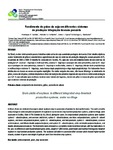Please use this identifier to cite or link to this item:
http://www.alice.cnptia.embrapa.br/alice/handle/doc/978380| Title: | Rendimento de grãos de soja em diferentes sistemas de produção integração lavoura-pecuária. |
| Authors: | SANTOS, H. P. dos  FONTANELI, R. S.   SPERA, S. T.   MALDANER, G. L.   |
| Affiliation: | HENRIQUE PEREIRA DOS SANTOS, CNPT; RENATO SERENA FONTANELI, CNPT; SILVIO TULIO SPERA, CPAMT; Geórgia Luiza Maldaner, UPF. |
| Date Issued: | 2013 |
| Citation: | Agrária, v. 8, n. 1, p. 49-56, jan./mar., 2013 |
| Pages: | 49-56 |
| Description: | No Brasil, existem relativamente poucos trabalhos sobre cultivo de soja sucedendo pastagens de inverno. Este trabalho objetivou avaliar rendimento de grãos e características agronômicas de soja em sistemas de produção integração lavoura-pecuária (ILP), no período de 2005 a 2008. O trabalho foi conduzido em Coxilha, RS, após dez anos de estabelecimento de seis sistemas de produção ILP: sistema I - trigo/soja e ervilhaca/milho; sistema II - trigo/soja e pastagem de aveia preta/milho; sistema III - trigo/ soja e pastagem de aveia preta/soja; sistema IV - trigo/soja e ervilha/milho; sistema V - trigo/soja, triticale duplo propósito/soja e ervilhaca/soja e sistema VI - trigo/soja, aveia branca duplo propósito/soja e trigo duplo propósito/soja. Os tratamentos foram distribuídos em blocos ao acaso com quatro repetições. Na média conjunta dos anos, não houve diferença no rendimento de grãos, massa de mil grãos, estatura de plantas e altura de inserção dos primeiros legumes de soja entre os sistemas de produção com ILP. A soja cultivada após ervilhaca mostrou maior número de legumes, número de grãos e massa de grãos por planta do que os demais sistemas de produção. In Brazil, there are relatively few papers about soybean crop in succession of pasture to steer performance. This work aimed to study changes in yield and yield components of soybean in succession in crop-livestock production systems, under no-tillage, were assessed in Coxilha, State of Rio Grande do Sul, Brazil, during ten years. Six crop-livestock production systems were studied: system I - wheat/soybean, and common vetch/corn; system II - wheat/soybean, and black oat pasture/corn; system III - wheat/ soybean, and black oat pasture/soybean; system IV - wheat/soybean, and field pea/corn; system V - wheat/soybean, common vetch/soybean, and triticale double purpose/soybean; and system VI - wheat/soybean, white oat double purpose/soybean, and double wheat purpose/soybean. The treatments were arranged in a completely randomized block design, with four replications. In the year, no differences were found between grain yields, weight of 1,000 kernels, plant height and insertion first legumes height of soybean in crop-livestock production systems. The soybean cultivated in succession after common vetch showed higher number of pods, number of grains and weight of grain per plant than the other crop systems. |
| Keywords: | Componente do Rendimento Grãos Sucessão de Cultura |
| ISSN: | 1981-1160 |
| DOI: | http://dx.doi.org/10.5039/agraria.v8i1a2077 |
| Type of Material: | Artigo de periódico |
| Access: | openAccess |
| Appears in Collections: | Artigo em periódico indexado (CPAMT)  |
Files in This Item:
| File | Description | Size | Format | |
|---|---|---|---|---|
| cpamtspera198111602013.pdf | 1.43 MB | Adobe PDF |  View/Open |









